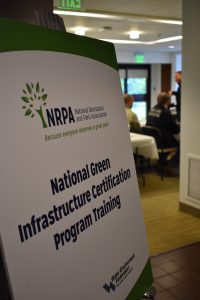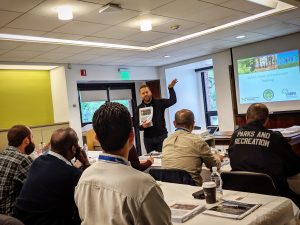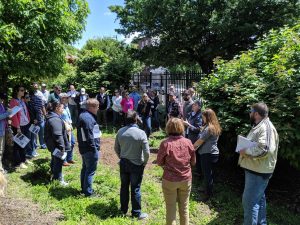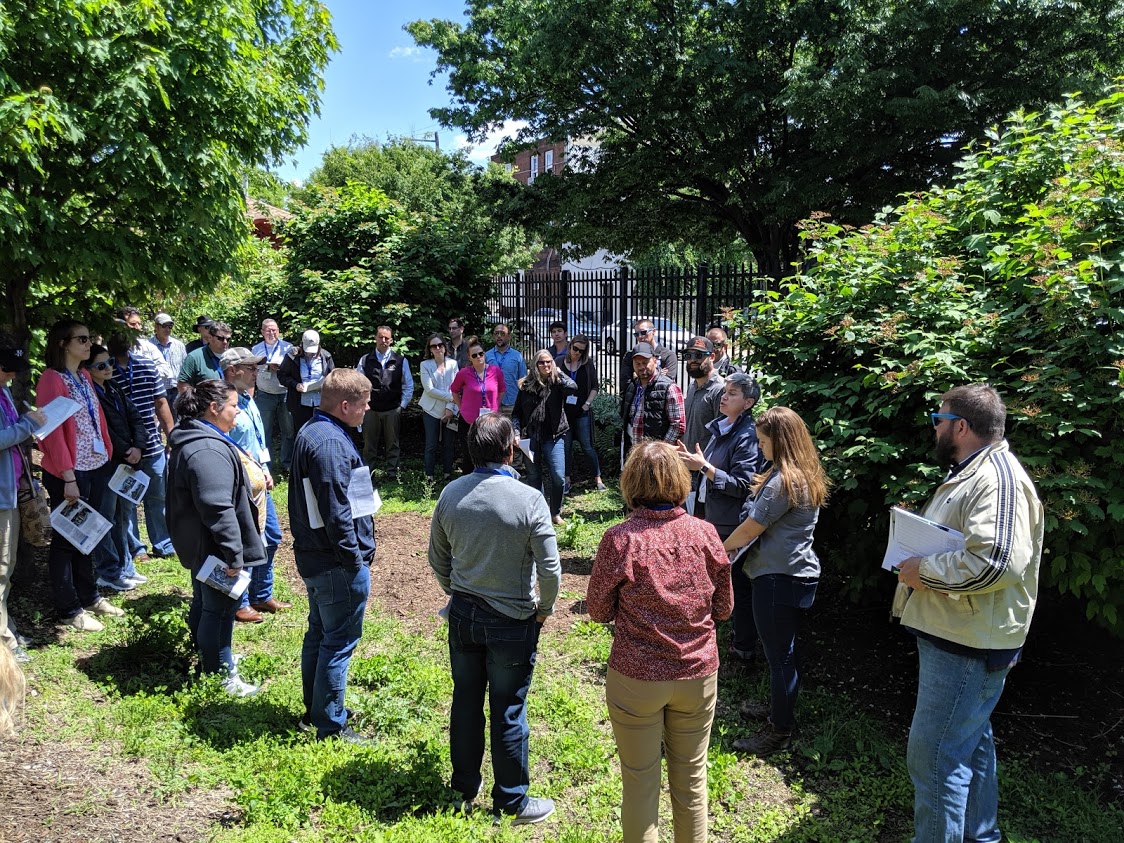
The National Recreation and Park Association (NRPA) selected 27 park professionals to attend a National Green Infrastructure Certification Program (NGICP) training in May. Photo courtesy of Jennifer Fulcher/NRPA.
In May, park professionals gathered in Philadelphia for a comprehensive course in green infrastructure design and management.
The National Recreation and Park Association (NRPA; Ashburn, Va.) selected 27 professionals to receive scholarships for green infrastructure training. The trainees spent two days learning hands-on lessons about how green infrastructure can provide multiple environmental and public health benefits, how to build these systems, and best practices to keep them in working order. They then took the National Green Infrastructure Certification Program (NGICP) exam on May 16. Those who pass the exam will become some of the first park professionals, as well as among the first 500 individuals overall, to receive NGICP certification.
Green infrastructure contributes to Great Urban Parks
NGICP, a national-level certification program developed by the Water Environment Federation (WEF; Alexandria, Va.) and DC Water, equips those working in the field with the knowledge they need to properly build, inspect, and maintain green stormwater infrastructure in the U.S. Incorporating green infrastructure in public parks can help improve the environment while also engaging and educating guests.
NRPA hosted the training event as part of its Great Urban Parks Campaign to improve community health, access to green space, and resiliency by implementing green stormwater management projects in parks. WEF and Philadelphia Parks & Recreation also supported the training.

Park professionals learned how to properly build, inspect and maintain green stormwater infrastructure during the NGICP event. Photo courtesy of Jennifer Fulcher/NRPA.
“This highlights that green infrastructure is not only a valuable approach in urban settings but can have multiple benefits in park landscapes as well,” said Eileen O’Neill, WEF executive director.
At the event, NGICP trainer Dwane Jones reviewed the extensive NGICP curriculum. He discussed the elements of different types of green infrastructure, including bioswales, rain gardens, green roofs, permeable pavement, cisterns, and dry wells, as well as strategies for safe construction and successful operation of these systems. He also stressed the importance of maintaining the projects after construction, ensuring they keep pace with increasing water stress brought on by urbanization.
“The idea behind green infrastructure is that we mimic or restore the natural hydrological balance,” Jones said. “As more people move into [urban] spaces, green infrastructure has a future position that will continue to grow and expand.”
Creating tomorrow’s technicians
Many of the trainees did not have much experience with the topic. Some had never even seen green infrastructure elements in person before. “I’m new to green infrastructure, so I had to do a lot of learning before I got here,” said Heidi Shegrud, landscape architect for Herriman City, Utah. She enjoyed the interactive nature of the NGICP curriculum, which includes quizzes for each section or module. “I appreciate this opportunity. It was

Trainees toured four park and playground sites in Philadelphia that incorporated green infrastructure. Photo courtesy of Jennifer Fulcher/NRPA.
really, really amazing to be a part of this,” she said.
Leveraging parks and open space to meet federal water-quality mandates is an essential part of Philadelphia’s comprehensive, nature-based approach to stormwater management. The training session highlighted the city’s green infrastructure during a half-day tour, visiting four sites. At each stop, trainees learned about the green infrastructure elements and maintenance plans in place from Philadelphia Parks & Recreation employees as well as members of the local community.
Building better systems and wider networks
The tour provided first-hand knowledge of how the city tackles stormwater issues and provided trainees tips for addressing similar stormwater issues in their communities.

The 27 park professionals who attended the NGICP training will take new skills and knowledge about stormwater management back to their communities across the U.S. Photo courtesy of Jennifer Fulcher/NRPA.
“I gained a lot of knowledge,” said Nick Makris, project supervisor for the City of Tarpon Springs, Fla. Makris said he appreciated “getting everyone’s perspective of the unique challenges that each of us face in our cities, our municipalities, our different regions.”
The in-person training also provided participants with a network of professionals that can provide information and support for future projects.
“My favorite part was getting to chat with everyone and build a green infrastructure network across the country,” said Rachel Ware, park planner for the Oklahoma City Parks and Recreation Department. Ware says she is one of the few proponents of green infrastructure in her region. She noted the benefits of learning more about green infrastructure in other locations. “[It] holds a lot of weight when I talk about it to the administration that manages our park system,” she said.
— Jennifer Fulcher, National Recreation and Park Association






